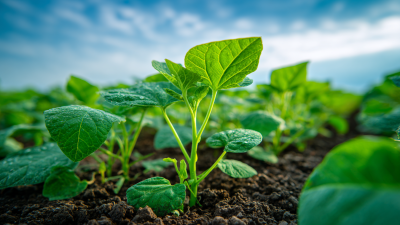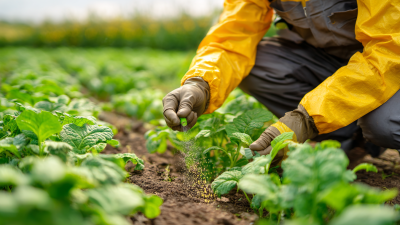 0551-68500918
0551-68500918 





The global Herbicides Market has really been booming lately. A big reason is the increasing need for smarter farming practices and higher crop yields. I came across a recent report from Research and Markets that says this segment could hit around USD 30 billion by 2027. That’s quite a jump, with an expected annual growth rate of about 5.3% from 2020 to 2027. Farmers today are more than ever trying to find that sweet spot—controlling weeds effectively without hurting the environment. Picking the right herbicides is pretty much crucial for that.

Companies like Innovation Meiland (Hefei) Co., LTD., based in Hefei, China, are really leading the charge here. They’re focused on developing innovative pesticide products, formulations, and processes. By understanding what modern agriculture needs, they aim to offer solutions that work for farmers and promote sustainable practices in the herbicide world. It’s all about keeping things balanced—effective, eco-friendly, and tailored to real farmers’ needs.
Figuring out exactly which weeds are growing in your fields is super important if you want to pick the right herbicides and get effective weed control. Every weed type has its own growth patterns, life cycle, and even resistance traits, so knowing what you're dealing with is key. Start by paying close attention to how these weeds look—things like leaf shape, how tall they grow, and when they flower. Jotting down these details can help you build a clear picture of what weeds are present, making your overall approach way more informed.
Once you’ve figured out what weeds you have, the next step is to do a bit of research on their vulnerabilities. Some weeds might grow like crazy under certain conditions but are pretty susceptible to specific herbicides during certain stages of their life. By understanding their growth cycle, you can time your Herbicide Application just right. Thistargeted tactic means you’ll hit the weeds where it counts—controlling them effectively while giving your crops a break. Basically, starting with proper identification sets the foundation for a smarter, more tailored weed management plan—leading to healthier plants and hopefully a better harvest overall.
When you're trying to pick the right herbicides for your farm, it’s really important to understand the different types out there. Basically, herbicides fall into two main categories: pre-emergent and post-emergent. Pre-emergent herbicides are like the first line of defense—they’re applied before weeds even start to grow, creating a sort of barrier in the soil that stops weed seeds from sprouting. Interestingly, according to the National Agricultural Statistics Service, farmers who use pre-emergent herbicides often see a boost in their yields—like 15-20% in crops like corn and soybeans—mainly because it keeps weeds in check right from the start.

Then there are the post-emergent herbicides, which you only apply once weeds have already emerged. These usually need certain weather conditions or precise application techniques to work best. The Weed Science Society of America reports that around 60% of the herbicide market is made up of post-emergent types, which just shows how important they are in everyday farming. Plus, many of these are selective, meaning they target specific weed species without harming your crops—that’s a big deal for avoiding damage.
Getting a good grip on these differences is pretty much step one for farmers who want to improve their yields while also keeping their weed problem under control. It’s all about choosing the right tool for the job, you know?
When it comes to choosing herbicides for farming, it's pretty important to think about how they might impact the environment. These chemicals can sometimes have unintended effects — like harming good insects, soil microbes, or nearby water ecosystems. Some types might even seep into the groundwater, which isn’t great when you consider it could end up in your drinking water. And others might stick around in the soil for a while, potentially affecting future crops and wildlife. So, it’s a good idea to pick products that are a bit gentler on nature — maybe go for selective herbicides that target specific weeds without messing up the surrounding plants and animals.
Plus, farmers should look into more sustainable methods to work alongside herbicides. Things like integrated pest management (IPM), crop rotation, and using cover crops can really help control weeds without always relying on chemicals.
Learning about the possible side effects of herbicides and using precise application techniques can also make a big difference in reducing risks. At the end of the day, being mindful of how these chemicals impact the environment not only helps keep ecosystems healthy but also supports productive farming. It’s all about finding that balance, right?
When you're choosing herbicides for your farm, it’s really important to understand how your different crops react to them. This is key to managing weeds effectively without accidentally harming your plants. You see, not all crops respond the same way—some can handle certain herbicides just fine, while others might get stressed out or even fail if you're not careful. So, taking the time to assess how your specific crops react to each herbicide can make a big difference.
Plus, things like how far along your plants are, the weather conditions, and when you apply the herbicide all matter a lot. For example, a herbicide that's safe for mature corn might end up damaging young seedlings or stressful situations like droughts. It’s super helpful to check out herbicide labels, contact university extension services, or look at crop sensitivity charts—they can really help you make smarter choices. By paying close attention to your crop's sensitivities, you can pick the right herbicides that keep weeds in check, help your crops grow healthy, and boost your yields—at the same time making your farming more sustainable in the long run.
| Herbicide Name | Target Weeds | Crop Sensitivity | Application Timing | Active Ingredient |
|---|---|---|---|---|
| Glyphosate | Annual and Perennial Grasses | Moderate | Pre- and Post-Emergence | Glyphosate |
| Atrazine | Broadleaf Weeds | High | Pre-Emergence | Atrazine |
| Dicamba | Dandelion, Milkweed | Low | Post-Emergence | Dicamba |
| 2,4-D | Broadleaf Weeds | Moderate | Early Post-Emergence | 2,4-D |
| S-metolachlor | Annual Grasses and Small Seeded Broadleaf Weeds | Low | Pre-Emergence | S-metolachlor |
When it comes to picking the right herbicides for farming, honestly, timing and how you apply them are super important if you wanna get the best results. The success really depends on factors like the weather, what stage your crops are at, and which weeds you're targeting. For example, pre-emergent herbicides need to go down before those pesky weed seeds sprout, while post-emergent ones should be applied when both crops and weeds are at just the right growth stage. That way, you can keep the weeds in check without accidentally damaging your crops.
And let’s not forget, how you actually put the herbicide on matters a lot, whether you're spraying from the air, using ground equipment, or drip systems. Some crops might respond better to certain application methods that help the herbicide really get in there and do its thing. Figuring all this out in the real world can help farmers develop smarter, more efficient practices—especially with all the new tech and formulations coming out, like those from companies such as Innovation Meiland (Hefei) Co., LTD. Keeping up with research and adjusting your strategies can make a huge difference in yields and sustainability. It’s all about staying flexible and being willing to learn as things evolve!”

When you're choosing herbicides for your farm, it's pretty important to keep an eye on your budget and how cost-effective each option is. It’s not just about the sticker price — understanding how different herbicides are priced can really help, especially since costs can vary a lot depending on the active ingredients and how you plan to use them. Before hitting the checkout button, take a moment to think about both the immediate costs and the bigger picture — like whether the herbicide will boost your yields or save you money in the long run by reducing weed problems. This isn’t just about the price per gallon; it’s also about how it might improve your crop health down the line or cut down on extra applications.
Also, think about how the herbicide you pick fits into your entire farming operation. Sometimes, going for the cheaper option upfront might seem smart, but it could backfire — leading to weed resistance, which might mean you need more treatments or even different products later, and that can really add up. The key is to weigh the costs against the long-term benefits — like healthier crops and fewer headaches — so you can make a choice that fits your budget while also being good for your farm’s sustainability. In the end, a bit of careful planning and considering the bigger picture can help you make smarter, more informed decisions about herbicides.
This chart illustrates the cost-effectiveness of various herbicides based on their price per hectare and weed control efficiency. The data reflects general market trends for weed management in agriculture.
: The main types of herbicides are pre-emergent and post-emergent herbicides. Pre-emergent herbicides target weeds before they germinate, while post-emergent herbicides are applied after weeds have emerged.
Pre-emergent herbicides can increase crop yields by 15-20% on average, as reported by farmers, by effectively preventing weed seedling development.
Post-emergent herbicides account for about 60% of the herbicide market and are crucial for targeting specific weed species after they have emerged without harming the desired crops.
Herbicides can affect non-target species like beneficial insects and soil microbes, leach into groundwater, and persist in the soil, which poses risks to future crops and ecosystems.
Farmers can choose products with a lower ecological footprint, use selective herbicides, implement Integrated Pest Management (IPM) strategies, crop rotation, and cover crops to manage weeds effectively.
The timing and method of application are crucial for maximizing herbicide effectiveness, with applications needing to be aligned with the growth stages of both crops and weeds, as well as considering weather conditions.
Common application methods for herbicides include aerial spraying, ground equipment, and drip systems, each offering different efficiencies and benefits depending on the crop.
Farmers can educate themselves about the potential off-target effects of herbicides and adopt precision application techniques to mitigate risks and enhance effectiveness.
The efficacy of herbicides can be influenced by weather conditions, the growth stages of crops and weeds, and the specific method of application used.
Continuous research and adaptation to new methodologies and advancements in Pesticide Formulations can lead to more efficient practices, improving agricultural outcomes and supporting sustainable farming.
When you're choosing the right herbicides for your farm, it’s really important to first figure out what kinds of weeds you’re dealing with. Knowing the different herbicides out there can make a huge difference in how you approach weed control. And let’s not forget, considering how these chemicals affect the environment is more important than ever, especially with all the talk about sustainability these days. Plus, you’ve got to check if your crops are sensitive to certain herbicides — nobody wants to damage the plants you’re actually trying to grow.
On top of that, how you apply the herbicide – the timing, method, all of that – really impacts how well it works. And of course, keeping an eye on your budget and figuring out what’s cost-effective is key to making smart choices without breaking the bank. The herbicide market is always changing, with new products and formulations popping up all the time. For instance, companies like Innovation Meiland (Hefei) Co., LTD. are working hard on new tech and ideas to help farmers get better results and do their part for the environment. Taking all these factors into account can really help farmers use herbicides smarter while keeping things eco-friendly.







